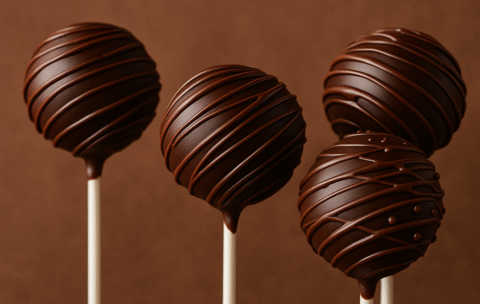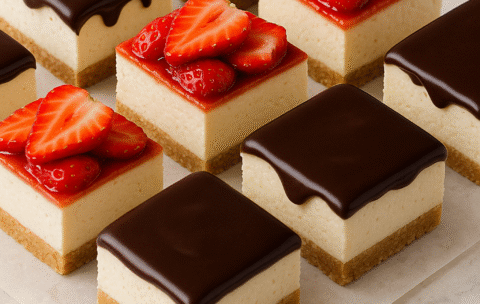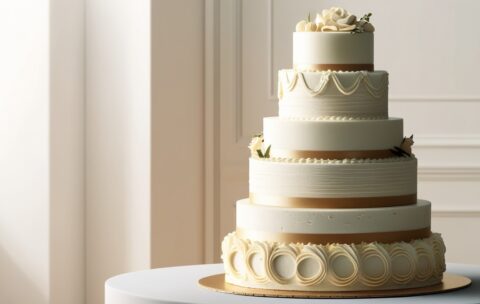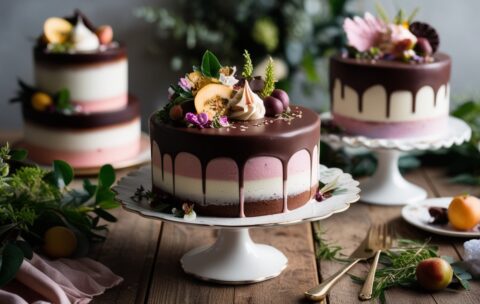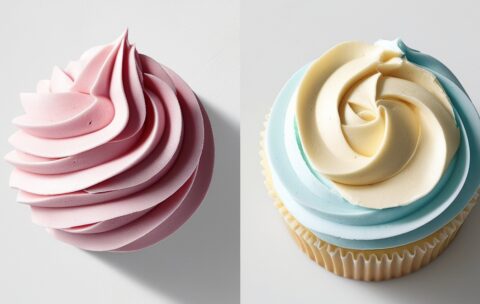Most popular
French Gateau & Entremet Principles
2 Lessons
1.3 hour
Intermediate
What you'll learn
Fundamental Structures: How to build entremets layer by layer—choosing and baking the right sponge (génoise, Joconde, biscuit cuillère), creating thin croustillant layers, and assembling mousse and bavarois tiers for height and stability.
Texture & Temperature Management: Techniques to ensure each component sets properly (e.g., mousse firmness, gelatin bloom, glaze viscosity) and how to keep layers distinct without bleeding.
Flavor Profiling & Balance: Pairing fruit purées, chocolate, nuts, and creams to achieve harmonious taste profiles. Understanding acidity, sweetness, and how to cut richness with complementary elements (fruit inserts, crunchy praline).
Advanced Finishing Techniques: Preparing and applying a smooth mirror glaze, torching velour sprays, using transfer sheets, and piping delicate decorations. Learning how to achieve a polished, professional look every time.
Assembly & Troubleshooting: Best practices for unmolding, repositioning, and storing entremets. Identifying and correcting common issues—sogginess, collapsed layers, uneven glazes.
Presentation & Plating: Strategies for cutting perfectly even slices, garnishing with textures (tuile, cocoa nibs, spun sugar), and arranging plated portions so they look as good as they taste.
Decadent Chocolate-Drizzled Cake Pops
4 Lessons
5.2 hours
Intermediate
What you'll learn
How to bake a moist cake base optimized for cake pops
Techniques for crumbling and mixing cake with fillings for consistent texture
Molding and chilling methods to form even, crack-free spheres
Proper chocolate tempering for glossy, snap-worthy coatings
Drizzling and decoration tips: two-tone drizzles, sprinkles, and edible embellishments
Storage and transport strategies to keep cake pops fresh and intact
Art of Fondant & Modeling Chocolate
4 Lessons
1.2 hour
Intermediate
What you'll learn
Fondant Fundamentals: How to knead, roll, and cover a cake in smooth fondant; troubleshooting common issues like tearing or cracking.
Color Mixing & Painting: Methods for achieving uniform pastel or vibrant hues using gel, powder, and airbrush techniques; blending shades for gradients and ombré effects.
Modeling Chocolate Preparation: Step-by-step process to make stable, pliable modeling chocolate at home—adjusting ratios for firmness or flexibility.
Sculpting Techniques: Building 3D elements (flowers, animals, figurines) layer by layer; using armature supports for larger models.
Texture & Embellishment: Creating realistic surface details—wood grain, lace patterns, ruffles, and draping—using molds, veiners, embossing tools, and impression mats.
Piping & Detailing: Accenting fondant and modeling chocolate pieces with royal icing, edible beads, and dusting powders to add dimension and realism.
Assembly & Structural Integrity: Best practices for attaching heavy sugar components to cake tiers; internal support systems (dowels, skewers) to ensure stability during transport and display.
No-Bake Cheesecake Layered Cake Squares
5 Lessons
3.5 hours
Intermediate
What you'll learn
Preparing and pressing the ideal crust (graham, cookie, or nut-based)
Mixing smooth, lump-free cheesecake filling with flavor variations (vanilla, citrus, chocolate)
Layering multiple cheesecake batters for striped or marbled effects
Setting and chilling methods to ensure clean, precise slices
Decorating techniques: fruit compotes, ganache drips, whipped cream piping
Cutting and serving tips to maintain sharp edges and professional presentation
Layer Cake Construction & Filling Strategies
3 Lessons
58 minutes
Intermediate
What you'll learn
Baking for Uniform Layers: How to prep pans (lining, spray), adjust batter distribution, and use baking strips or temperature hacks for flat, even cake tops.
Leveling & Stacking: Knife vs. cake leveler methods; applying a thin “crumb coat” of frosting; inserting dowels or straws for multi-tier support; stacking layers without slippage.
Filling Varieties & Textures: Selecting between custards, curds, fruit compotes, ganaches, buttercreams, and mousse fillings—considering sweetness, moisture control, and pairings (e.g., raspberry curd with chocolate cake).
Preventing Leaks & Weeping: Techniques for sealing cake layers (buttercream dam, chocolate collar), ensuring fillings stay contained; chilling strategies to set fillings before final coating.
Flavor Harmony & Balance: Matching cake flavor (vanilla, chocolate, spice) with filling profiles (tart, sweet, creamy) to avoid one element overpowering another; adjusting sweetness levels.
Finishing & Presentation Prep: Applying a smooth final coat of frosting or ganache; creating optional decorative borders or piped accents; slicing tips for clean, even servings.
Cinnamon Sugar–Coated Churro Cake Bites
3 Lessons
4 hours
Intermediate
What you'll learn
How to bake and crumble a base cake optimized for cake bites
Ratio of cake crumbs to filling for ideal texture and binding
Frying vs. baking methods for a golden, light crust
Blending and heating cinnamon-sugar coating for crisp adhesion
Shaping techniques for uniform, crack-free bites
Serving and storage tips to keep bites fresh and crunchy
Vegan & Gluten-Free Cake Innovations
3 Lessons
1.5 hour
Intermediate
What you'll learn
Flour Blends & Ratios: How to create balanced gluten-free flour mixes (almond, oat, rice, sorghum) and adjust for different cake styles (sponges, pound cakes, chiffon).
Binder Techniques: Use flaxseed meal, chia gel, and aquafaba as egg replacers to provide lift and cohesion; troubleshoot sticky or crumbly batters.
Moisture Control: Incorporate nondairy milks (almond, oat, coconut), fruit purées, and oil ratios to maintain tenderness without a gummy crumb.
Sweetener Alternatives: Work with maple syrup, coconut sugar, and date paste; understand how liquid versus granulated sweeteners affect texture and browning.
Flavor Innovations: Develop unique cake profiles—matcha-coconut layer, cacao-beet marble, citrus-herb infusion—using natural colorants and extracts.
Frosting & Filling Adaptations: Prepare stabilized coconut whipped cream, aquafaba meringue buttercream, and avocado-chocolate ganache; learn to pipe and decorate without dairy.
Baking Adjustments: Modify oven temperatures, bake times, and pan preparations for even rise and minimal collapse in vegan/gluten-free batters.
Troubleshooting: Identify and fix issues like dense crumb, dryness, or collapse; use gentle folding, resting times, and moisture tests to ensure success.
Troubleshooting & Refinement Workshop
4 Lessons
2.9 hours
Intermediate
What you'll learn
Identifying Baking Flaws
Recognize symptoms: wet centers, domed tops, tunneling.
Distinguish oven, ingredient, and mixing–related causes.
Adjusting Recipes & Techniques
Modify ratios for moisture balance and crumb structure.
Tweak mixing times to avoid over- or undermixing.
Oven Calibration & Bake Environment
Test for hot spots with simple cake tester method.
Optimize rack placement and temperature adjustments.
Emergency Fixes During Baking
Rescue sinking cakes mid-bake with tented foil or reduced heat.
Correct cracked tops by adjusting cooling and humidity.
Refinement Practices
Use test batches to fine-tune recipes.
Record observations and standardize best practices.
Buttercream Icing Techniques
5 Lessons
59 minutes
Intermediate
What you'll learn
Buttercream Foundations: Basic ratios for American, Swiss, Italian, and French buttercreams; key differences in texture, sweetness, and stability.
Temperature Control: How to handle ingredients (room-temperature vs. chilled butter, sugar syrup stages) to prevent graininess or separation.
Flavoring & Infusing: Incorporating extracts, fruit purées, ganache, or cocoa; balancing sweetness and fat without compromising consistency.
Coloring Strategies: Best practices for gel vs. powdered colors; preventing “bleeding” or streaking when blending multiple hues (e.g., ombré or watercolor effects).
Spreading & Smoothing: Techniques for achieving glass-smooth sides (bench scraper, icing turntable, hot spatula method) and avoiding common marks or air pockets.
Piping & Decorative Textures: Creating rosettes, ruffles, ruffles, basketweave, petals, and multi-tone piping (hidden two-tone tips, reversible bags).
Stabilizing for Warm Climates: Adjusting recipes (adding meringue powder or corn syrup) so buttercream holds shape in humid or warm environments.
Troubleshooting Common Issues: Fixing grainy buttercream, curdled mixtures, overly soft or too-stiff icing; rescue methods (re-creaming, adjusting sugar syrup).
Decorative Piping & Sugar Flowers
3 Lessons
4.3 hours
Intermediate
What you'll learn
Icing Consistency & Color Blending
Adjusting buttercream and royal icing to the proper firmness for different piping tasks.
Techniques for tinting icing and gum paste to achieve natural, gradient effects.
Piping Basics to Advanced Motifs
Foundational strokes (dots, lines, shells) leading to scrolls, rosettes, ruffles, and lace patterns.
Creating texture, dimension, and contrast through varying pressure, speed, and tip selection.
Sugar Flower Construction
Preparing and conditioning gum paste and fondant for pliability.
Forming petals, leaves, and buds for common flowers (roses, peonies, ranunculus).
Assembling individual elements into realistic bouquets and sprays.
Composition & Placement
Designing balanced cake layouts: focal points, color harmony, and scale.
Securing decorations on tiered and multi-surface cakes without collapse.
Troubleshooting & Finishing Touches
Preventing issues such as cracking, sagging, or color bleeding.
Applying final details: dusting, veining, and edible luster for lifelike appearance.
Trending
French Gateau & Entremet Principles
2 Lessons
1.3 hour
Intermediate
What you'll learn
Fundamental Structures: How to build entremets layer by layer—choosing and baking the right sponge (génoise, Joconde, biscuit cuillère), creating thin croustillant layers, and assembling mousse and bavarois tiers for height and stability.
Texture & Temperature Management: Techniques to ensure each component sets properly (e.g., mousse firmness, gelatin bloom, glaze viscosity) and how to keep layers distinct without bleeding.
Flavor Profiling & Balance: Pairing fruit purées, chocolate, nuts, and creams to achieve harmonious taste profiles. Understanding acidity, sweetness, and how to cut richness with complementary elements (fruit inserts, crunchy praline).
Advanced Finishing Techniques: Preparing and applying a smooth mirror glaze, torching velour sprays, using transfer sheets, and piping delicate decorations. Learning how to achieve a polished, professional look every time.
Assembly & Troubleshooting: Best practices for unmolding, repositioning, and storing entremets. Identifying and correcting common issues—sogginess, collapsed layers, uneven glazes.
Presentation & Plating: Strategies for cutting perfectly even slices, garnishing with textures (tuile, cocoa nibs, spun sugar), and arranging plated portions so they look as good as they taste.
Decadent Chocolate-Drizzled Cake Pops
4 Lessons
5.2 hours
Intermediate
What you'll learn
How to bake a moist cake base optimized for cake pops
Techniques for crumbling and mixing cake with fillings for consistent texture
Molding and chilling methods to form even, crack-free spheres
Proper chocolate tempering for glossy, snap-worthy coatings
Drizzling and decoration tips: two-tone drizzles, sprinkles, and edible embellishments
Storage and transport strategies to keep cake pops fresh and intact
Art of Fondant & Modeling Chocolate
4 Lessons
1.2 hour
Intermediate
What you'll learn
Fondant Fundamentals: How to knead, roll, and cover a cake in smooth fondant; troubleshooting common issues like tearing or cracking.
Color Mixing & Painting: Methods for achieving uniform pastel or vibrant hues using gel, powder, and airbrush techniques; blending shades for gradients and ombré effects.
Modeling Chocolate Preparation: Step-by-step process to make stable, pliable modeling chocolate at home—adjusting ratios for firmness or flexibility.
Sculpting Techniques: Building 3D elements (flowers, animals, figurines) layer by layer; using armature supports for larger models.
Texture & Embellishment: Creating realistic surface details—wood grain, lace patterns, ruffles, and draping—using molds, veiners, embossing tools, and impression mats.
Piping & Detailing: Accenting fondant and modeling chocolate pieces with royal icing, edible beads, and dusting powders to add dimension and realism.
Assembly & Structural Integrity: Best practices for attaching heavy sugar components to cake tiers; internal support systems (dowels, skewers) to ensure stability during transport and display.
No-Bake Cheesecake Layered Cake Squares
5 Lessons
3.5 hours
Intermediate
What you'll learn
Preparing and pressing the ideal crust (graham, cookie, or nut-based)
Mixing smooth, lump-free cheesecake filling with flavor variations (vanilla, citrus, chocolate)
Layering multiple cheesecake batters for striped or marbled effects
Setting and chilling methods to ensure clean, precise slices
Decorating techniques: fruit compotes, ganache drips, whipped cream piping
Cutting and serving tips to maintain sharp edges and professional presentation
Layer Cake Construction & Filling Strategies
3 Lessons
58 minutes
Intermediate
What you'll learn
Baking for Uniform Layers: How to prep pans (lining, spray), adjust batter distribution, and use baking strips or temperature hacks for flat, even cake tops.
Leveling & Stacking: Knife vs. cake leveler methods; applying a thin “crumb coat” of frosting; inserting dowels or straws for multi-tier support; stacking layers without slippage.
Filling Varieties & Textures: Selecting between custards, curds, fruit compotes, ganaches, buttercreams, and mousse fillings—considering sweetness, moisture control, and pairings (e.g., raspberry curd with chocolate cake).
Preventing Leaks & Weeping: Techniques for sealing cake layers (buttercream dam, chocolate collar), ensuring fillings stay contained; chilling strategies to set fillings before final coating.
Flavor Harmony & Balance: Matching cake flavor (vanilla, chocolate, spice) with filling profiles (tart, sweet, creamy) to avoid one element overpowering another; adjusting sweetness levels.
Finishing & Presentation Prep: Applying a smooth final coat of frosting or ganache; creating optional decorative borders or piped accents; slicing tips for clean, even servings.
Cinnamon Sugar–Coated Churro Cake Bites
3 Lessons
4 hours
Intermediate
What you'll learn
How to bake and crumble a base cake optimized for cake bites
Ratio of cake crumbs to filling for ideal texture and binding
Frying vs. baking methods for a golden, light crust
Blending and heating cinnamon-sugar coating for crisp adhesion
Shaping techniques for uniform, crack-free bites
Serving and storage tips to keep bites fresh and crunchy
Vegan & Gluten-Free Cake Innovations
3 Lessons
1.5 hour
Intermediate
What you'll learn
Flour Blends & Ratios: How to create balanced gluten-free flour mixes (almond, oat, rice, sorghum) and adjust for different cake styles (sponges, pound cakes, chiffon).
Binder Techniques: Use flaxseed meal, chia gel, and aquafaba as egg replacers to provide lift and cohesion; troubleshoot sticky or crumbly batters.
Moisture Control: Incorporate nondairy milks (almond, oat, coconut), fruit purées, and oil ratios to maintain tenderness without a gummy crumb.
Sweetener Alternatives: Work with maple syrup, coconut sugar, and date paste; understand how liquid versus granulated sweeteners affect texture and browning.
Flavor Innovations: Develop unique cake profiles—matcha-coconut layer, cacao-beet marble, citrus-herb infusion—using natural colorants and extracts.
Frosting & Filling Adaptations: Prepare stabilized coconut whipped cream, aquafaba meringue buttercream, and avocado-chocolate ganache; learn to pipe and decorate without dairy.
Baking Adjustments: Modify oven temperatures, bake times, and pan preparations for even rise and minimal collapse in vegan/gluten-free batters.
Troubleshooting: Identify and fix issues like dense crumb, dryness, or collapse; use gentle folding, resting times, and moisture tests to ensure success.
Troubleshooting & Refinement Workshop
4 Lessons
2.9 hours
Intermediate
What you'll learn
Identifying Baking Flaws
Recognize symptoms: wet centers, domed tops, tunneling.
Distinguish oven, ingredient, and mixing–related causes.
Adjusting Recipes & Techniques
Modify ratios for moisture balance and crumb structure.
Tweak mixing times to avoid over- or undermixing.
Oven Calibration & Bake Environment
Test for hot spots with simple cake tester method.
Optimize rack placement and temperature adjustments.
Emergency Fixes During Baking
Rescue sinking cakes mid-bake with tented foil or reduced heat.
Correct cracked tops by adjusting cooling and humidity.
Refinement Practices
Use test batches to fine-tune recipes.
Record observations and standardize best practices.
Buttercream Icing Techniques
5 Lessons
59 minutes
Intermediate
What you'll learn
Buttercream Foundations: Basic ratios for American, Swiss, Italian, and French buttercreams; key differences in texture, sweetness, and stability.
Temperature Control: How to handle ingredients (room-temperature vs. chilled butter, sugar syrup stages) to prevent graininess or separation.
Flavoring & Infusing: Incorporating extracts, fruit purées, ganache, or cocoa; balancing sweetness and fat without compromising consistency.
Coloring Strategies: Best practices for gel vs. powdered colors; preventing “bleeding” or streaking when blending multiple hues (e.g., ombré or watercolor effects).
Spreading & Smoothing: Techniques for achieving glass-smooth sides (bench scraper, icing turntable, hot spatula method) and avoiding common marks or air pockets.
Piping & Decorative Textures: Creating rosettes, ruffles, ruffles, basketweave, petals, and multi-tone piping (hidden two-tone tips, reversible bags).
Stabilizing for Warm Climates: Adjusting recipes (adding meringue powder or corn syrup) so buttercream holds shape in humid or warm environments.
Troubleshooting Common Issues: Fixing grainy buttercream, curdled mixtures, overly soft or too-stiff icing; rescue methods (re-creaming, adjusting sugar syrup).
Decorative Piping & Sugar Flowers
3 Lessons
4.3 hours
Intermediate
What you'll learn
Icing Consistency & Color Blending
Adjusting buttercream and royal icing to the proper firmness for different piping tasks.
Techniques for tinting icing and gum paste to achieve natural, gradient effects.
Piping Basics to Advanced Motifs
Foundational strokes (dots, lines, shells) leading to scrolls, rosettes, ruffles, and lace patterns.
Creating texture, dimension, and contrast through varying pressure, speed, and tip selection.
Sugar Flower Construction
Preparing and conditioning gum paste and fondant for pliability.
Forming petals, leaves, and buds for common flowers (roses, peonies, ranunculus).
Assembling individual elements into realistic bouquets and sprays.
Composition & Placement
Designing balanced cake layouts: focal points, color harmony, and scale.
Securing decorations on tiered and multi-surface cakes without collapse.
Troubleshooting & Finishing Touches
Preventing issues such as cracking, sagging, or color bleeding.
Applying final details: dusting, veining, and edible luster for lifelike appearance.
Popular Topics
cake pops
cheesecake bars
Sugar Artistry
churro cake bites
no-bake desserts
Gluten-Free Flours
cinnamon sugar
Smooth Finish Techniques
dessert assembly
Cake Stability
Gateau Techniques
Entremet Construction
DessertRecipes
layered cheesecake
Royal Icing Techniques
easy baking
Gum Paste Florals
American Buttercream
French Buttercream
dessert bite
NoBakeRecipes
party snacks
dessert bites
single-portion baking
party treats
tempering chocolate
Vegan Baking
ChocolateCake
warm spices
Sugar Flowers
cream cheese frosting
Mirror Glaze
Buttercream Variations
Cake Decorating
PastryFundamentals
Layer Cakes
Cake Assembly
BakedDesserts
Buttercream & Ganache
Baking Refinement
Professional Techniques
flavor pairings
CakeDecor
Egg Replacements
VictoriaSponge
international cakes
Color Blending & Airbrushing
Panettone
Middle Eastern sweets
NakedCake
holiday cakes
SemiNakedCake
Cake Troubleshooting
CakeDesign
petite cake design
PastrySkills
MinimalistDesserts
Decorative Piping
nut variations
Genoise
chocolate mousse
sponge bases
BakingBasics
Popular Instructors
All Cakes Courses
Filter by category
Filter by
We found 18 courses available for you
No-Bake Cheesecake Layered Cake Squares
5 Lessons
3.5 hours
Intermediate
“No-Bake Cheesecake Layered Cake Squares” is a focused mini-course that …
€17.33
What you'll learn
Preparing and pressing the ideal crust (graham, cookie, or nut-based)
Mixing smooth, lump-free cheesecake filling with flavor variations (vanilla, citrus, chocolate)
Layering multiple cheesecake batters for striped or marbled effects
Setting and chilling methods to ensure clean, precise slices
Decorating techniques: fruit compotes, ganache drips, whipped cream piping
Cutting and serving tips to maintain sharp edges and professional presentation
Decadent Chocolate-Drizzled Cake Pops
4 Lessons
5.2 hours
Intermediate
“Decadent Chocolate-Drizzled Cake Pops” is a hands-on mini-course that guides …
€42.39€77.89
What you'll learn
How to bake a moist cake base optimized for cake pops
Techniques for crumbling and mixing cake with fillings for consistent texture
Molding and chilling methods to form even, crack-free spheres
Proper chocolate tempering for glossy, snap-worthy coatings
Drizzling and decoration tips: two-tone drizzles, sprinkles, and edible embellishments
Storage and transport strategies to keep cake pops fresh and intact


